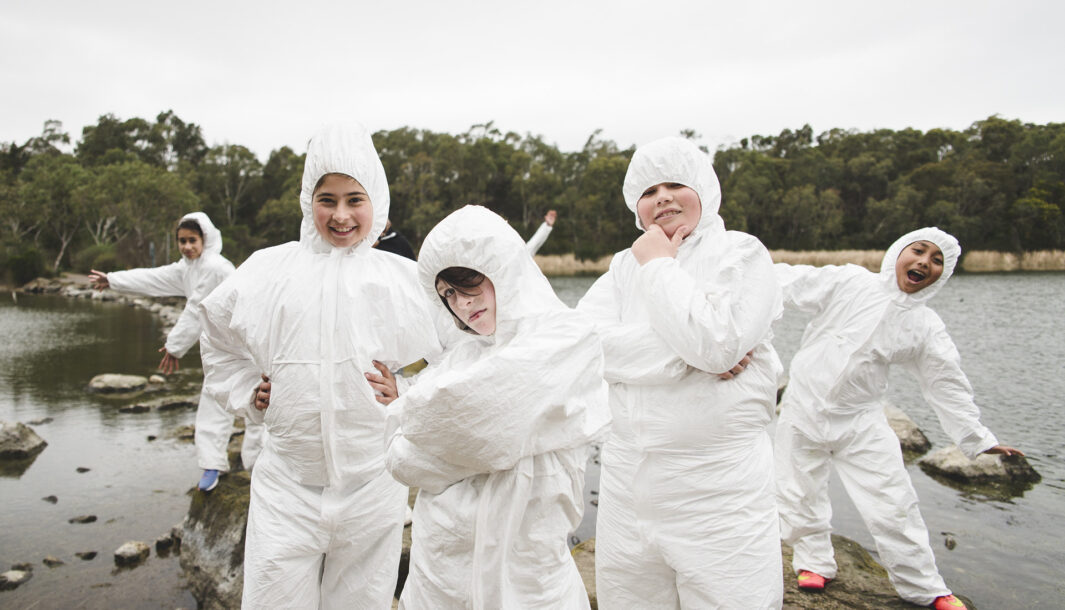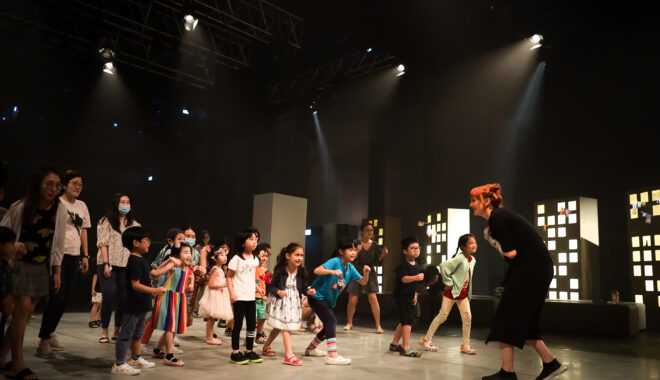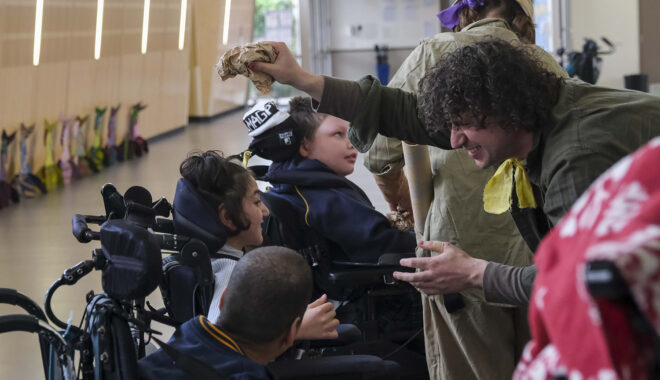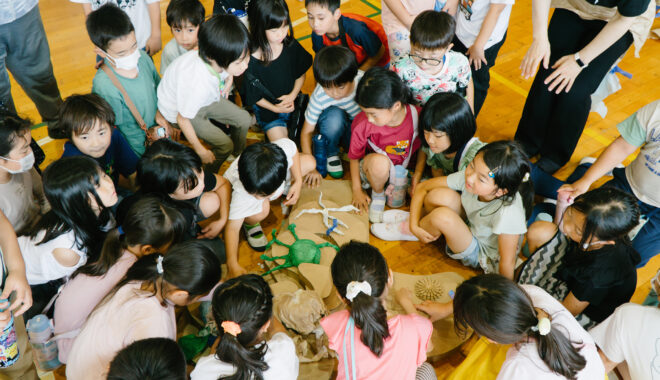22 Apr 2020 Education News
The ethics of children’s participation

By Sarah Austin
As a theatre-maker who works with children and young people in a range of contexts (including within schools and community, for Youth Arts organisations, mainstream theatre programs and independent theatre productions), I am acutely aware of the responsibility of constructing the frame from within which the young people are viewed.
In 2008, following a complaint from a high-profile children’s protection advocate, New South Wales police seized twenty art works from the Roslyn Oxley9 gallery in Sydney prior to the opening of an exhibition by celebrated Australian photographer Bill Henson. At the time, the NSW Department of Public Prosecutions were investigating allegations of child pornography by Henson. The works in question were part of Henson’s ongoing investigation into the liminal state of childhood and adolescence, and, as the artist argued at the time, were part of the Western tradition of nudes. They had garnered considerable acclaim worldwide and were exhibited as part of the 2005 Venice Biennale. Further adding to the public concern in Australia was then Prime Minister Kevin Rudd’s denouncement of the work as ‘disgusting’ and in response to the narratives of sexuality that the work explored, Rudd publicly stated he believed we should ‘just let kids, be kids’ [1].
There are many ways of framing this moment in Australian art history, and there are questions of authorship, morality, censorship and free speech which all emerge in an interrogation of why this occurred and how it played out in the public arena. There are also many ways to critically and ethically engage with Henson’s complex and beautiful works depicting adolescence. From my perspective, as a theatre practitioner who makes contemporary performance work with and for children and young people (and at the time of the controversy I was the Artistic Director and Chief Executive Officer of one of Australia’s largest government-funded youth theatre companies) [2], it became a watershed moment in my practice. I was particularly caught with Rudd’s statement, ‘just let kids, be kids’ and the kind of overwhelming popular support this notion seemed to have. What were the discourses that were shaping and defining these understandings of childhood that Rudd was referring to? Who was responsible for creating, circulating and maintaining these ideas? And crucially, for the work I was interested in creating, where was the voice of children in this debate and what agency did they have in addressing these views of them?
During the Henson affair children were never publicly asked for their opinion on the work and it seemed this work was popularly understood as only relevant and suitable for adult audiences. As Australian social theorist Joanne Faulkner has argued, and as Rudd’s statement demonstrates, there is a tendency in Western culture to reduce childhood to an idyllic innocence which reduces children’s interests to “in need of protection”, and ultimately serves to fetishise their vulnerability [3]. In her book The Importance of Being Innocent: Why We Worry About Children (2010) Faulkner argues that our focus on children’s vulnerability is a direct result of our ‘rigid understanding of childhood as unworldly, incapable and pure.’ [4] Adult-child relations are predicated on this political construct of childhood and children as vulnerable; Henson’s work simultaneously disrupts and plays on this dominant idea. Further, the artist’s work also complicates notions of the cultural agency of children and young people by distorting our understandings of who is responsible for controlling the gaze while raising questions about how these photographs have been created.
At times, I have seen contemporary performance work featuring children where I have also felt confronted, and thought that the ethics of creation, and of production, were questionable. Henson’s works, and my experiences over the last decade seeing and making work that features children onstage, raises important questions of how children may function as political symbols in art, and how the process of creation and framing of work needs careful ethical consideration.
This thinking regarding the ethics of children’s participation has led me to the development of a model of creative practice I term a rights-based approach to collaborating with children and young people. Drawing on my experiences as a theatre-maker, this model is designed to address ethical considerations inherent in any creative collaboration with children, including how power operates in adult-child relations. A rights-based approach to creative collaboration with children responds directly to a number of articles within the UN Convention on the Rights of the Child including but not limited to:
- Article 12 Children have the right to say what they think should happen when adults are making decisions that affect them and to have their opinions taken into account
and
- Article 13 The child shall have the right to freedom of expression; this right shall include freedom to seek, receive and impart information and ideas of all kinds, regardless of frontiers, either orally, in writing or in print, in the form of art, or through any other media of the child’s choice.
Drawing on these obligations as framing statements for the intentions of collaborative creative practice, I have developed three key constituent features of a rights-based framework of working with children in performance as detailed below:
- Blended methodologies from the practices and philosophies that underpin both Youth Arts and inclusive arts
These creative methods include creative approaches to story-sharing, non-verbal, visual and kinaesthetic approaches to developing creative material and play-based enquiries, as well as other generative tasks as part of the creative process.
- Acknowledging and addressing power imbalances
This includes strategies for creating brave, safe and inclusive spaces for rehearsal and performance, strategies for diffusing knowledge amongst all collaborators. Importantly, commitments from adult collaborators to cede power where possible and resist the expert/amateur dichotomy inherent in adult-child social relations.
- Child-led, child-centric contexts and dramaturgies
Adult collaborators must be committed to practices that comprehend children’s rights and respect and take seriously the information children impart. Further, child-led dramaturgies may be in opposition to the adult-constructed values and views of what constitutes critically successful performance. These new forms must be embraced as part of a rights-based approach. The creative strategies must focus on children’s strengths and capacities rather than their perceived deficits or vulnerabilities, and, in doing so, provide a platform for the (sometimes disruptive) insertion of children’s ideas, opinions, views and visions into a range of contexts.
Ultimately, I believe that a rights-based approach to creative collaborations with children and young people might alter dominant power relations, with its focus on trusting young people and their capacity, providing a brave and inclusive space in which it is possible to take risks.
Footnotes
[1] See for example: Matthew Westwood. “PM says Henson photos have no artistic merit,” The Australian, published May 23, 2008, https://www.theaustralian.com.au/news/nation/nude-teen-exhibit-not-art-rudd/news-story/5fc28c4c5ffd0ec7261d4ad4b34fb743.
[2] I’m referring here to Melbourne’s St Martins Youth Arts Centre, a 40-year old youth arts company that creates original performance work with, by and for children and young people aged between 5-25 years. I occupied the role of Artistic Director/CEO at the company from 2008-2014. www.stmartinsyouth.com.au
[3] Joanne Faulkner, The Importance of Being Innocent: Why We Worry about Children (Cambridge University Press: Melbourne, 2011), 10
[4] Faulkner, The Importance of Being Innocent, 3
Further reading:
Faulkner, Joanne. The Importance of Being Innocent: Why We Worry about Children. Melbourne: Cambridge University Press. 2011
Budd, Natasha. Staging Childhoods; Experiments in Authentic theatre making with Children. PhD Thesis, Queensland University of Technology. 2014 https://eprints.qut.edu.au/76092/
Loreman, Tim. Respecting Childhood. London: Bloomsbury, 2009.
https://youtu.be/ftRGzscTE74
Link to a keynote from the author at the 2019 CONVERGE Young people and the Arts Summit at the Abbotsford Convent.
https://vimeo.com/277576475
Link to a keynote delivered by four children aged 10-12 years and the author Sarah Austin, and her collaborator and colleague Alex Walker as part of the 2018 Creative State Summit in Melbourne, Victoria.
Biography
Sarah Austin is an award-winning theatre-maker who specialises in working with children and young people in contemporary performance. She is a Lecturer in Theatre at the Victorian College of the Arts and submitted her PhD in 2019. This article is an excerpt from that research project titled Ethics, Agency and Disruption: Toward a rights-based practice of working with children in contemporary performance.







